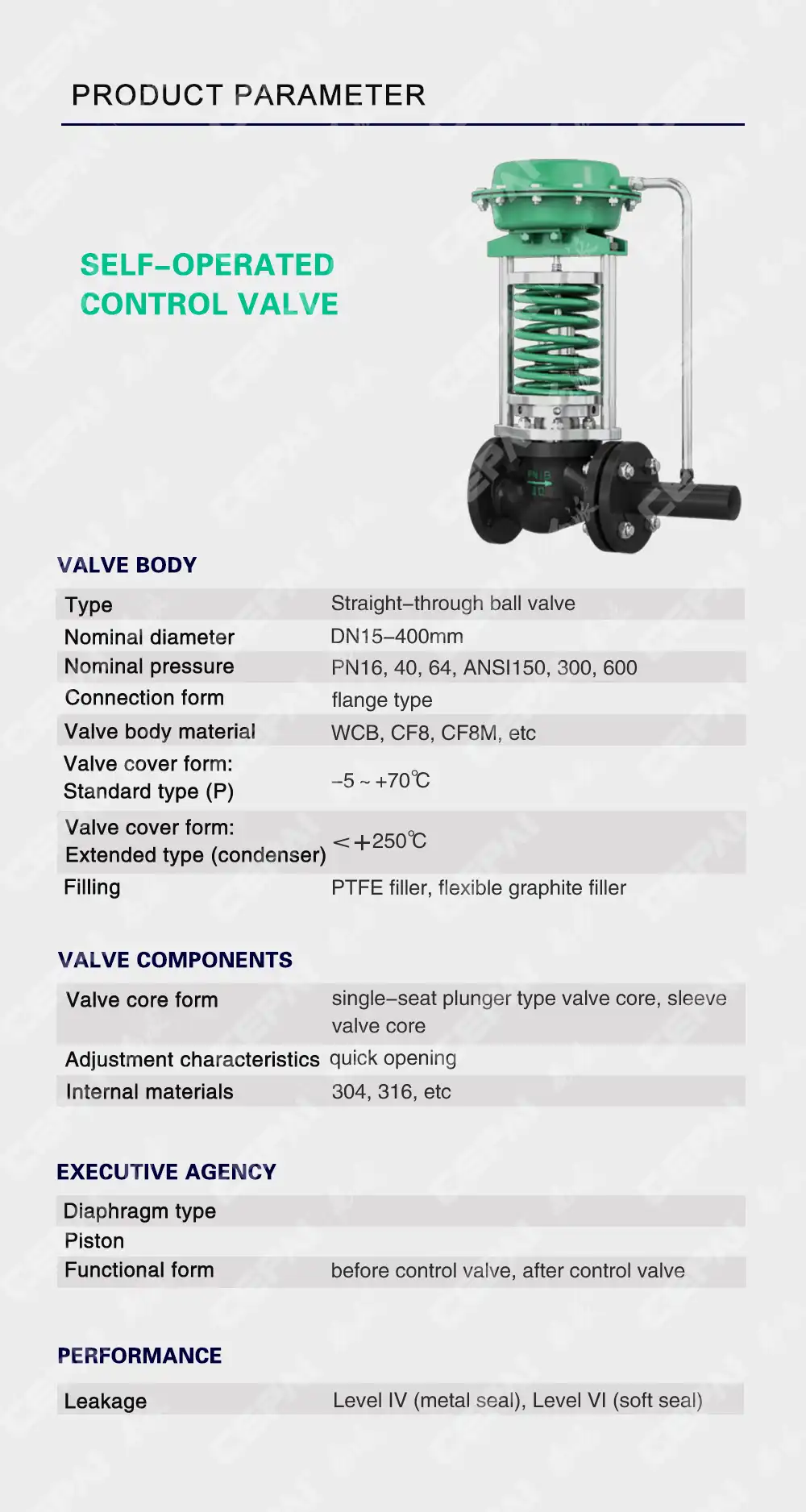Understanding the Principles of Self-Operated Control Valves
Mechanism of Operation
Self-operated control valves function on a simple yet ingenious principle. They utilize the pressure differential within the system to actuate the valve, eliminating the need for external power sources or complex control systems. As fluid flows through the valve, it creates a pressure difference that acts on a diaphragm or piston. This force is balanced against a spring, allowing the valve to modulate its position and maintain the desired set point. The self-regulating nature of these valves ensures consistent performance even in fluctuating process conditions.
Key Components
The anatomy of a self-operated control valve includes several critical components working in harmony. The main body houses the valve seat and plug, which control the flow path. A sensing element, typically a diaphragm or bellows, detects changes in process variables. The actuator, often spring-loaded, responds to these changes by adjusting the valve position. An adjustable set point mechanism allows operators to fine-tune the valve's response. Understanding these components is crucial for proper valve selection, installation, and maintenance.
Types of Self-Operated Control Valves
Self-operated control valves come in various configurations to suit different applications. Pressure-reducing valves maintain a constant downstream pressure regardless of upstream fluctuations. Back-pressure regulators ensure a minimum upstream pressure. Temperature regulators modulate flow based on temperature changes. Flow limiters restrict flow rates to predetermined levels. Each type has unique characteristics and is designed for specific control scenarios. Selecting the appropriate valve type is essential for optimal system performance and efficiency.
Applications and Benefits of Self-Operated Control Valves
Industrial Applications
Self-operated control valves find widespread use across numerous industries. In oil and gas production, they regulate wellhead pressure and manage gas lift operations. Chemical processing plants utilize these valves for precise reactant flow control and product separation. HVAC systems employ them for temperature regulation and steam distribution. Water treatment facilities rely on self-operated valves for maintaining consistent water pressure and chemical dosing. Their versatility and reliability make them indispensable in scenarios where continuous, accurate flow control is paramount.
Advantages Over Powered Alternatives
Compared to electrically or pneumatically actuated valves, self-operated control valves offer distinct advantages. Their operation independent of external power sources enhances system reliability and reduces downtime risks. The simplicity of design translates to lower maintenance requirements and increased longevity. Energy efficiency is another key benefit, as these valves operate solely on the energy within the fluid. In remote or hazardous locations, where power supply might be challenging or explosive atmospheres are a concern, self-operated valves provide a safe and practical solution.
Cost-Effectiveness and ROI
Investing in self-operated control valves often yields significant returns. The initial cost may be higher than basic manual valves, but the long-term benefits far outweigh this investment. Reduced energy consumption, minimal maintenance needs, and improved process efficiency contribute to lower operating costs. The precise control these valves offer can lead to improved product quality and reduced waste in manufacturing processes. Furthermore, their ability to operate without external power sources eliminates the need for expensive control systems and power infrastructure, particularly beneficial in remote installations.
Selection, Installation, and Maintenance Best Practices
Choosing the Right Valve
Selecting the appropriate self-operated control valve requires careful consideration of several factors. Flow characteristics, pressure ratings, and temperature ranges must align with the specific application requirements. The valve's materials of construction should be compatible with the process fluid to prevent corrosion and ensure longevity. Sizing is crucial; an undersized valve may not provide adequate control, while an oversized one can lead to instability and poor performance. Consider future process changes or expansions when selecting a valve to ensure it remains suitable for long-term use. Consulting with valve experts or manufacturers can provide valuable insights into selecting the optimal valve for your specific needs.
Installation Guidelines
Proper installation is vital for the optimal performance of self-operated control valves. Ensure the valve is installed in the correct orientation, respecting flow direction and any specific mounting requirements. Adequate straight pipe runs upstream and downstream of the valve help maintain stable flow conditions and accurate control. Proper support and stress relief are essential to prevent pipe strain from affecting valve operation. Install isolation valves and bypass lines to facilitate maintenance without disrupting the entire system. Careful attention to these installation details can significantly enhance valve performance and lifespan.
Maintenance and Troubleshooting
Regular maintenance is key to ensuring the longevity and reliability of self-operated control valves. Develop a preventive maintenance schedule that includes visual inspections, leak checks, and performance tests. Pay special attention to seals, diaphragms, and springs, as these components are subject to wear over time. Calibrate set points periodically to maintain accurate control. When troubleshooting, common issues include sticking valves, incorrect set points, or worn components. Keeping detailed maintenance records can help identify recurring issues and predict when replacements might be necessary. Training operators and maintenance personnel in proper valve care and troubleshooting techniques can significantly reduce downtime and extend valve life.
Conclusion
Self-operated control valves represent a cornerstone of efficient fluid control systems across various industries. Their ability to provide precise, autonomous regulation without external power sources makes them invaluable in countless applications. By understanding their principles, applications, and maintenance requirements, engineers and plant operators can leverage these devices to enhance process efficiency, reduce costs, and improve overall system reliability. As industries continue to evolve, the role of self-operated control valves in ensuring smooth, efficient operations remains more critical than ever.
Contact Us
For expert guidance on selecting and implementing self-operated control valves tailored to your specific needs, contact CEPAI Group. Our advanced valve solutions offer unparalleled performance, durability, and efficiency, ensuring optimal control in even the most demanding applications. Reach out to us at cepai@cepai.com to discover how our innovative products can transform your fluid control systems.

_1746598531170.webp)



